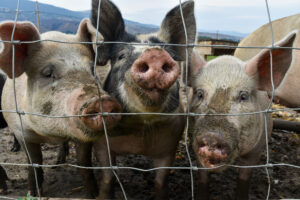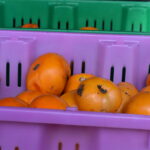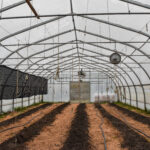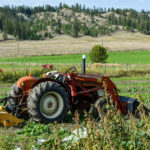2.3 Structures, Tools, and Fencing
Structures and Production Areas

- Animals will need shelter (with the size appropriate to the number of animals you have), insulated in the winter, a fenced outdoor area, feed storage, and fencing.
- Compost area – You will need space for several piles or windrows of compost, as well as piles of the carbon inputs that you add as you add your nitrogren sources (greens) like plant debris and food scraps (your carbon sources (browns) like wood chips, leaves, small branches, straw, etc).
- Crop storage – See section 5.0 for details
- Gathering space – This is a space where people can sit and gather in; it could have a fire pit, hammocks, BBQ, a big table in the middle, or just chairs. You could meet here for meetings with staff/volunteers, invite friends and family over, or have meals with large amount of people.
- Greenhouse/season extension tunnels – Permanent or temporary structures for season extension might include row tunnels, caterpillar tunnels.
- Market preparation – Indoor/covered space to prepare vegetables for market/sales. It is important to be out of the elements, as crops will need to stay dry as you are bunching them, and putting them in boxes for the farmers’ market or CSA boxes.
- Nursery – You can plant seedlings inside a building, in a greenhouse, etc. but you will need a warm space to grow all of the seedlings that you need.
- Seed storage – If you save any seeds, you will need space to store them in a cool, dry area
- Storage area for harvest bins, tools, and other equipment.
- Washing Station – Potable running water and large sink to wash crops in. This could be an outdoor station. Ensure that while you are washing the majority of your crops, you are standing straight up, as this is a position you (or someone else) will be in for hours every week for months. You can build your own, or buy one, there are many options and designs to pick from. There should be a large counter space next to the sink as well for vegetables to dry off a bit.
- Water/irrigation systems – Depending on your water and irrigation system, you might have a pond, water pump, well, or irrigation lines.
- Produce bins
- Greenhouse in November
- Tractor
Tools
Some common tools include the following, many of which can be borrowed or rented:
- Gloves – keep your hands warm and clean
- Hand pruners (for each farm worker)
- Small kitchen knife (for each farm worker) – what you will use to harvest a majority of your crops
- Scale – large enough to weigh 50lb boxes for record keeping
- Stirrup/Dutch hoe or Wire weeder for easy weeding
- Stick for making holes in the garden beds when planting (see drawing below)
- Shovels
- Wheelbarrows
- Bins to store harvested produce in, that nests and stacks, and has holes for ventilation. Around the size of 20 x 13 x 6″ works well, as it holds about 35lb of produce which is easy to carry for one person.
- Boxes to bring produce to market in, may have lids to stack higher
More information on tools and maintenance can be found on this The Market Gardener page.
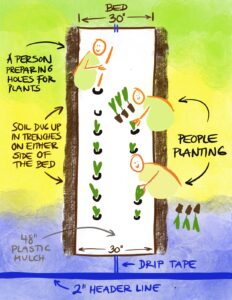
Equipment
All of these are optional and will depend on the size and scale of your operation:
- ATV or golf cart (depending on your terrain) to move yourself and equipment around the property, and on harvesting days, stacking all of your boxes of produce in to drive back to your washing/sorting area
- Tractor – you can borrow one if/when you need one
- Rototiller – optional, may be able to borrow one
- Wood chipper to chip branches and woody debris for your compost pile or mulch
- Chainsaw if trees fall down and you need to clear them
- Seed saving equipment – you can borrow a winnower and thresher from the Kamloops Food Policy Council

Fencing
Fencing is needed to both keep animals in, and animals out of areas. There are several types of fencing including:
- Portable/mobile fencing might be used for rotational grazing practices when you want to move the animals every few days. Examples include poultry netting, mobile pens, or electric wire.
- Perimeter fencing that is very high (7.5-8ft high) to keep out deer that have permanent posts in the ground, and plastic, wood, or metal fencing between posts. This can also be topped with electrical wire or barbed wire.
- Permanent fencing around animal paddocks or small fields that might not need to be as high if you already have perimeter fencing for deer, but instead keeps animals in, and protects against predators like lynx, foxes, or skunks.
There are many considerations to make when deciding on fencing, and your needs may change over the years. It is something that usually needs to be done right away if there is no fencing installed already. Research the needs of your enterprise, talk to your neighbors to see what works (or doesn’t) for them, and other experts in town.
